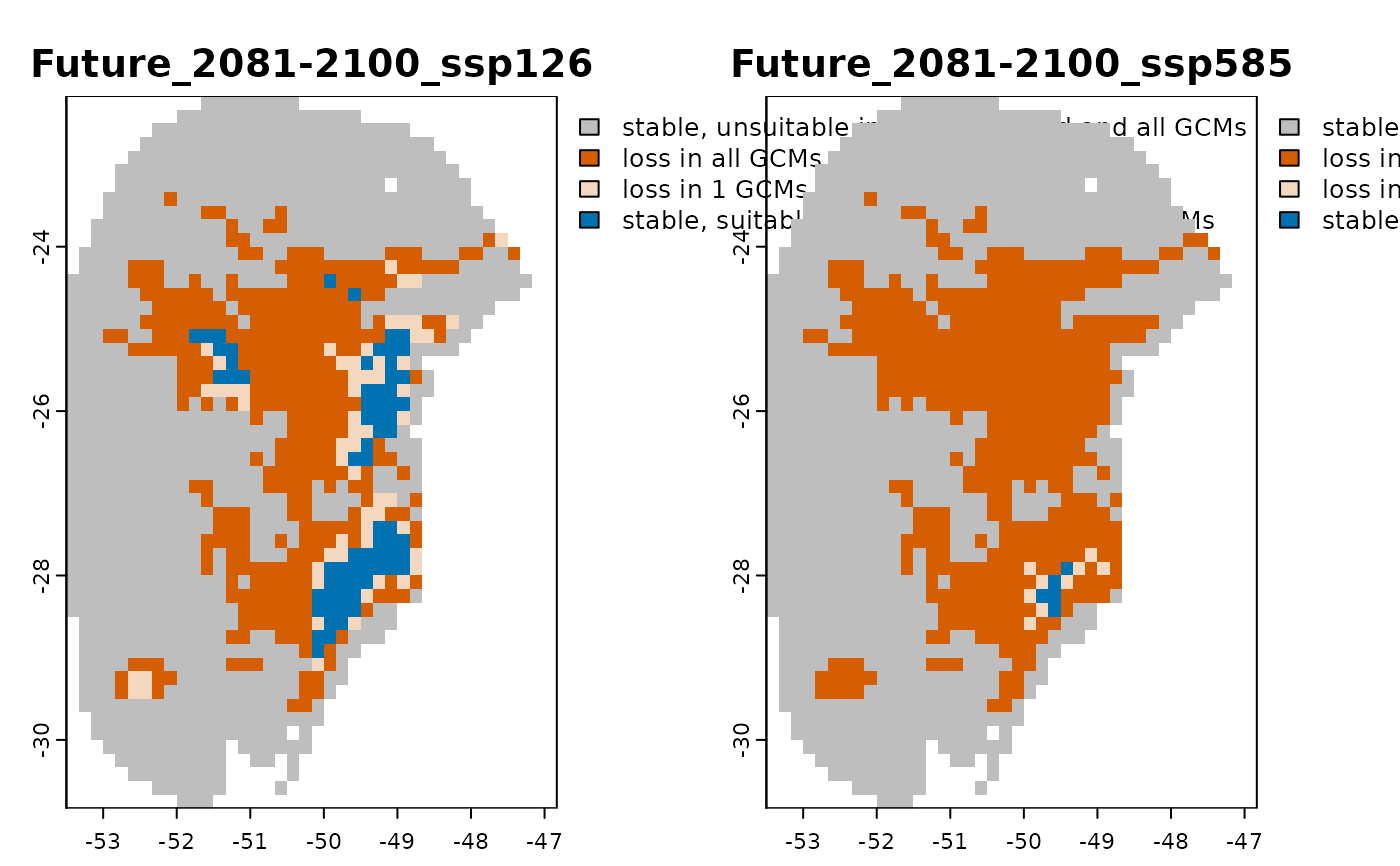This functions sets the color tables associated with the SpatRaster object
resulting from projection_changes(). Color tables are used to associate specific colors with raster values when using plot(). This function defines custom colors for areas of gain, loss, and stability across scenarios.
Usage
colors_for_changes(
changes_projections,
gain_color = "#009E73",
loss_color = "#D55E00",
stable_suitable = "#0072B2",
stable_unsuitable = "grey",
max_alpha = 1,
min_alpha = 0.25
)Arguments
- changes_projections
an object of class
changes_projections, generated byprojection_changes()or imported usingimport_projections(), containing the$Summary_changeselement.- gain_color
(character) color used to define the pallete for representing gains. Default is "#009E73" (teal green).
- loss_color
(character) color used to define the pallete for representing losses. Default is "#D55E00" (orange-red).
- stable_suitable
(character) color used for representing areas that remain suitable across all scenarios. Default is "#0072B2" (oxford blue).
- stable_unsuitable
(character) color used for representing areas that remain unsuitable across all scenarios. Default is "grey".
- max_alpha
(numeric) opacity value (from 0 to 1) for areas where all GCMs agree on the change (gain, loss, or stability). Default is 1.
- min_alpha
(numeric) opacity value (from 0 to 1) for areas where only one GCM predicts a given change. Default is 0.25
Value
An object of class changes_projections with the same structure and
SpatRasters as the input changes_projections, but with color tables
embedded in the SpatRasters. These colors are used automatically when
visualizing the data with plot().
Examples
# Step 1: Organize variables for current projection
## Import current variables (used to fit models)
var <- terra::rast(system.file("extdata", "Current_variables.tif",
package = "kuenm2"))
## Create a folder in a temporary directory to copy the variables
out_dir_current <- file.path(tempdir(), "Current_raw_color_example")
dir.create(out_dir_current, recursive = TRUE)
## Save current variables in temporary directory
terra::writeRaster(var, file.path(out_dir_current, "Variables.tif"))
# Step 2: Organize future climate variables (example with WorldClim)
## Directory containing the downloaded future climate variables (example)
in_dir <- system.file("extdata", package = "kuenm2")
## Create a folder in a temporary directory to copy the future variables
out_dir_future <- file.path(tempdir(), "Future_raw_color_example")
## Organize and rename the future climate data (structured by year and GCM)
### 'SoilType' will be appended as a static variable in each scenario
organize_future_worldclim(input_dir = in_dir, output_dir = out_dir_future,
name_format = "bio_",
fixed_variables = var$SoilType)
#>
|
| | 0%
|
|========= | 12%
|
|================== | 25%
|
|========================== | 38%
|
|=================================== | 50%
|
|============================================ | 62%
|
|==================================================== | 75%
|
|============================================================= | 88%
|
|======================================================================| 100%
#>
#> Variables successfully organized in directory:
#> /tmp/Rtmphkhpn9/Future_raw_color_example
# Step 3: Prepare data to run multiple projections
## An example with maxnet models
## Import example of fitted_models (output of fit_selected())
data(fitted_model_maxnet, package = "kuenm2")
## Prepare projection data using fitted models to check variables
pr <- prepare_projection(models = fitted_model_maxnet,
present_dir = out_dir_current,
future_dir = out_dir_future,
future_period = c("2081-2100"),
future_pscen = c("ssp126", "ssp585"),
future_gcm = c("ACCESS-CM2", "MIROC6"),
raster_pattern = ".tif*")
# Step 4: Run multiple model projections
## A folder to save projection results
out_dir <- file.path(tempdir(), "Projection_results/maxnet_color_example")
dir.create(out_dir, recursive = TRUE)
## Project selected models to multiple scenarios
p <- project_selected(models = fitted_model_maxnet, projection_data = pr,
out_dir = out_dir)
#>
|
| | 0%
|
|============== | 20%
|
|============================ | 40%
|
|========================================== | 60%
|
|======================================================== | 80%
|
|======================================================================| 100%
# Step 5: Identify areas of change in projections
## Contraction, expansion and stability
changes <- projection_changes(model_projections = p, by_gcm = TRUE,
by_change = TRUE, write_results = FALSE,
return_raster = TRUE)
#Step 6: Set Colors for Change Maps
changes_with_colors <- colors_for_changes(changes_projections = changes)
terra::plot(changes_with_colors$Summary_changes)
